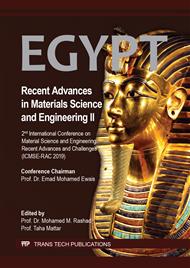[1]
H. Palaniswamy, A. Nasser, Forming of advanced high-strength steels (AHSS). Sheet metal forming processes and applications, Metal Park, ASM International (2012).
DOI: 10.31399/asm.tb.smfpa.t53500107
Google Scholar
[2]
D. L. Chen, Z. G. Wang, X. X. Jiang, S. H. Ai, C. H. Shih, The dependence of near- threshold fatigue crack growth on microstructure and environment in dual phase steels, Mater. Sci. Eng. 108 (1989) 141-151.
DOI: 10.1016/0921-5093(89)90415-2
Google Scholar
[3]
H. K. D. A. Bahadeshia, Ferrite formation in heterogeneous dual-phase steels, Scripta Metal, 17 (1983) 857-860.
DOI: 10.1016/0036-9748(83)90249-1
Google Scholar
[4]
T. Furukawa, M. Tanion, Structure formation and mechanical properties, Proc. Conf., Fundamentals of Dual Phase steels, ed., R. A. Kot and L. Bramfitt, AIME, Chicago, III., (1981), p.221.
Google Scholar
[5]
Fatih Hayat, HüseyinUzun,Effect of heat treatment on microstructure, mechanical properties and fracture behavior of ship and dual phase steels,Journal of Iron and SteelResearch, International, 18 Issue 8 (2011) 65-72.
DOI: 10.1016/s1006-706x(11)60106-4
Google Scholar
[6]
Aydin Hüseyin, KazdalZeytinHavva, KubilayCeylan,Effect of intercritical annealing parameters on dual phase Behavior of Commercial Low-Alloyed steel,Journal of Iron and steelResearch, International, 17 Issue 4 (2010)73-78.
DOI: 10.1016/s1006-706x(10)60089-1
Google Scholar
[7]
P. Movahed, S. Kolahgar, S.P.H. Marashi, M. Pouranvari, N. Parvin,The effect of intercritical heat treatment temperature on the tensile properties and work hardening behavior of ferrite–martensite dual phase steel sheets,Materials Science and Engineering, 518 Issue 1-2 (2009) 1-6.
DOI: 10.1016/j.msea.2009.05.046
Google Scholar
[8]
E. Ahmad, T. Manzoor, N. Hussain, N.K. Qazi, Effect of thermomechanical processing on hardenability and tensile fracture of dual phase steel, Materials & Design, 29 Issue2 (2008) 450-457.
DOI: 10.1016/j.matdes.2006.12.022
Google Scholar
[9]
Xuan Liang, Jun Li, YingHong Peng,Effect of water quench process on mechanical properties of cold rolled dual phase steelmicroalloyed with niobium, Materials Letters, 62 Issue2 (2008) 327-329.
DOI: 10.1016/j.matlet.2007.05.034
Google Scholar
[10]
L. Gao, Y.M. Zhou, J.L. Liu, X.D. Shen, Z.M. Ren,Effect of water quenching process on the microstructure and magnetic property of cold rolled,Journal of Magnetism and Magnetic Materials, 322 Issue8 (2010) 929-933.
DOI: 10.1016/j.jmmm.2009.11.026
Google Scholar
[11]
Sun S, Pugh M. Properties of thermomechanically processed dual-phase steels containing fibrous martensite. Mater Sci Eng A 335 (2002);:298–308.
DOI: 10.1016/s0921-5093(01)01942-6
Google Scholar
[12]
Demir B, Erdog˘an M. The hardenability of austenite with different alloy content and dispersion in dual-phase steels. J Mater Process Technol 208(2008) 75-84.
DOI: 10.1016/j.jmatprotec.2007.12.094
Google Scholar
[13]
R.R.U. Queiroz, F.G.G. Cunha and B.M. Gonzalez Study of dynamic strain aging in dual-phase steel,, Materials Science and Engineering A 543(2012) 84-87.
DOI: 10.1016/j.msea.2012.02.050
Google Scholar
[14]
A. Farahat, S. Ayyad, A. El-Desouky, W. M. Farouk, A. Kassab, Effect of hot forging and Boron content on the mechanical properties of dual phase steel, 15th international Conference on Aerospace Sciences and Aviation Technology, Cairo, Egypt May 28-30 (2013) paper ASAT-15-115-MS.
DOI: 10.21608/asat.2013.22115
Google Scholar
[15]
J. Vinas, L. Kascak, Analysis of weldability of dual-phase steel used in automotive industry, Zeszzty Naukowe politechniki Rzesowskiej, 293, Mechanika 88 (2016) 259-266.
DOI: 10.7862/rm.2016.21
Google Scholar
[16]
P. K. Ghosh, P. C. Gupta, Ramavtar, B. K. Jha, Weldability of dual phase steel under flash butt welding process, Proc. Int. Conf., Welding Technologyin Developing countries Present Status and Future Needs, Univ. of Roorke, India (1988) 11-53.
Google Scholar
[17]
B. K. Jha, Ramavtar, V. S. Dwivedi, V. Ramaswamy, Flash butt welding of Dual-phase steel- case study,Welding Technologyin Developing countries Present Status and Future Needs, Univ. of Roorke, India (1988) 111-199.
Google Scholar
[18]
S. Ulu, M. Cakmakkaya, S. Talas, Effect of MAG welding on microstructure and mechanical properties of dual phase steel, Kovove Mater., 53 (2015) 9-16.
DOI: 10.4149/km_2015_1_9
Google Scholar


